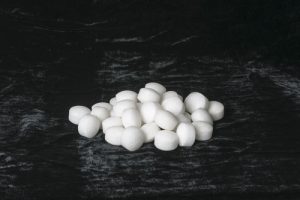Do Mothballs Repel Animals?
By Chris Williams on December 1, 2011.
Mothballs, moth crystals, or moth cakes are an age-old remedy for getting rid of everything from moths, to cockroaches, to squirrels in the attic. But do mothballs really work to repel animals from an area?
The first thing to know is that mothballs or moth crystals are considered to be pesticides and are regulated by the Environmental Protection Agency. They contain either naphthalene or paradichlorobenzene as the active ingredient. Because they are regulated by EPA, use of the products in any manner not in accordance with the product’s label is illegal. Mothball labels direct you to use the product only inside tightly sealed containers where the fumes are contained. Mothballs or moth crystals are not to be used in open areas where the vapors can be inhaled by people.
 There are commercial repellent products available that contain naphthalene and sulfur and that have labels that do allow their use to repel rodents, snakes, raccoons, skunks, squirrels, bats, woodpeckers, and others. The manufacturers of these products claim that these “area repellents” irritate the animals’ noses or respiratory tract, cause general distress, and ultimately drive them from the area. For most situations and most animals, these products give poor results. Experts say that naphthalene does repel bats but only if used at 100% concentration (most products are 7% naphthalene), and only if the area is tightly confined so that the concentration remains high. But most attics and areas where bats roost cannot be tightly sealed (and if they were sealed, how would the bats get out?).
There are commercial repellent products available that contain naphthalene and sulfur and that have labels that do allow their use to repel rodents, snakes, raccoons, skunks, squirrels, bats, woodpeckers, and others. The manufacturers of these products claim that these “area repellents” irritate the animals’ noses or respiratory tract, cause general distress, and ultimately drive them from the area. For most situations and most animals, these products give poor results. Experts say that naphthalene does repel bats but only if used at 100% concentration (most products are 7% naphthalene), and only if the area is tightly confined so that the concentration remains high. But most attics and areas where bats roost cannot be tightly sealed (and if they were sealed, how would the bats get out?).
Research has not shown that either naphthalene or paradiclorobenzene effectively repel animals from an area. If an animal has other nest sites, or has just moved into the area, mothballs may cause it to leave. But if there is only one choice nesting area available, and especially if there are young involved, mothballs are not going to move that animal out of its nest site.
Sometimes mothballs or moth crystals get undeserved credit because (1) they were applied at the time of year that the animal was getting ready to leave the nest site anyway; or (2) the animal is just checking-out the area and never intended to remain at all; or (3) the physical disturbance of applying the mothballs (not the odor itself) drives the animal away. Something has changed in its environment and it doesn’t like change.
You also need to consider the effects of high levels of naphthalene or paradichlorobenzene on the human inhabitants of your home. Naphthalene is considered to have low mammalian toxicity, but some people are very sensitive to it. Mothballs or crystals are highly toxic if ingested. And there’s no question that the odor is strong and not especially desirable. If you can smell mothballs, you are inhaling the pesticide.
Animal repellents may, or may not, work, but this is like putting a band-aid on the problem. The best way to get rid of unwanted nuisance animals in or around your home is to humanely trap them out of the space and then seal openings so that the animals cannot re-enter – something we do all the time at Colonial. Don’t subject your family to the odor and mess of repellents. Instead, contact Colonial Pest for a free quote, or call us at 1-800-525-8084 right now, for a permanent solution to your nuisance animal problem.
Sign up for our biweekly email newsletter for more information about bugs and pests!